This year I am 33 years old, I just started trading coins for 2 years, and I have made about 10 million with a capital of 10,000. I have never worked after graduating from university. I spend all day watching videos and recording data.
1. With an initial capital of 10,000, I did projects in college, affiliate marketing, brushing orders, delivery, filling tasks in apps, and saved up to 10,000.
2. Entering the crypto market, I think BTC is too expensive, so I keep playing ETH, which has leverage, and then there are altcoin spots. Choose coins and do proper position management. Just follow this simple thought, and when the market is bad, take small losses; when the market comes, make a big profit.
Why enter the market?
If you want to change your destiny, you must try in the crypto world. If you can't get rich in this circle, ordinary people will have no chance in their lifetime.
I'm sharing my thoughts on trading coins with everyone:
Many people start trading contracts with only 10,000 capital (about 1,400 U), thinking 'it's a small capital, just do it.'
But the truth is: the smaller the capital, the more you need position management.
Large capital can rely on time, while small capital depends entirely on discipline. Otherwise, a single blowout will require recharging 'faith.'
The following method is suitable for contract traders with capital between 5000 to 20000 RMB, aiming not to double in a day, but for low drawdown and steady growth.

Small capital trading contracts is not about making a BMW with each trade but rather making enough for a phone case each month, which after 12 times turns into an iPhone.
Compound rhythm:
Monthly target profit: 10% - 20%
Control the maximum single loss to not exceed 2% of the total account capital.
Swing positions allow holding for 1-5 days, adjusting stop-loss in between.
Step 1: Segment accounts, delineate the 'battle fund pool'
Account: 10,000 yuan ≈ 1,400 U
Divide into 4 trading segments, each worth 350U
Use only one segment for trading, leave the others untouched
Essentially giving yourself 4 lives, getting rescued if you make mistakes
Benefits: Resistant to consecutive stop losses, will not lose all ammunition at once.
Step 2: Control each risk to be within 1%-2% of total capital
Recommended practice: Control the stop-loss amount for a single position to be within 140 U (about 10%).
For example, trading BTC:
The difference between the entry point and the stop-loss point = 500 USDT
Using 10 times leverage means a fluctuation of 50 USDT.
To not exceed a risk of 140 U, you can open at most 2.8 BTC contracts ≈ 3 contracts.
→ This is the process of reverse position calculation.
Remember this: it's not about how many lots you want to open, but how many the market allows you to open.
Step 3: Pyramid increase positions, only amplify position when making profits.
If you've bought low and made a floating profit of 100 U, you can consider:
Increase part of the position and continue to ride the trend upward.
Raise the stop-loss to the breakeven or profit area.
The remaining part can attack freely, risk control has protected oneself.
This way, even if the market retraces, you can retreat without harm.
Increase positions only if there are floating profits, do not increase losses!
Step 4: Market grading, determine position strength.
Market Types
Position recommendations
For illustration
Obscure oscillation
Empty or very small positions
Wait for clear direction before entering.
Clear Breakthrough
Half position entry
Support/Resistance Confirmation Breakthrough
Trend Acceleration
Full position + Increasing position
Strong momentum, chasing acceleration waves
High Stagnation/Divergence
Reduce positions or take profits
Secure profits, avoid counterattacks.
This is the 'Market Rating - Position Ratio' mindset. It's not the position that decides first, but the market that decides first.
There is a simplest method for trading coins that allows you to maintain 'eternal profits'!
Last year, I played with 200,000, and now I have 20 million, easily achieving a hundredfold profit. This method I still use now (suitable for everyone) is high and very stable.
Place importance on this in your later trading process, it can help you earn an extra 3 to 10 points daily.
In this bull market, if you have 500,000 U and want to reach 10 million U, it's not about the luck of being 'the chosen one,' but a complete set of extreme restraint + extreme aggression rolling position system.
The secret to success can be summed up in one sentence: protect your capital, let profits soar.
[Step 1] Choose coins: only trade 'main upward trend coins.'
Capital should not be scattered; focus your bets on 'trends + control' coins:
Break through previous highs, with volume: like SOL breaking 25 dollars, not waiting for retail investors to react before it surged 5 times.
Segment leading sectors: MEME, AI, Layer 2, avoid 'new wine in old bottles' pseudo-hotspots.
Low circulation, easy to pull: market capitalization between 100 million to 1 billion U, making it easy for the main trader to control.
[Step 2] Rolling position strategy: only use profits to increase positions, capital only enters and does not exit.
500,000 U does not seek to double overnight, but rather to step by step:
First trade: 200,000 trial position, signals must be clear - breakout + increased volume (like PYTH breaking 0.6)
Stop-loss: cut losses at 10%, no emotions, preserve your ammunition.
Increase positions after a 50% profit: reinvest 300,000 (capital + profit) to catch the main upward trend.
After doubling, roll in all positions: 1 million U to impact 3-5 times, do not be greedy, do not hesitate.
Take profit half when a 15% drawdown occurs, hold the rest till the end.
Key discipline: Never increase positions while losing, only amplify bets when winning.
[Step 3] Position control iron rule: leverage 20 times, rely on restraint rather than bravery.
Single currency position should not exceed 40% of total capital: at any time, do not go all in.
Double profits and withdraw capital: when growing from 500,000 to 1 million, first withdraw 500,000 for safety.
Each stop-loss should not exceed 5-10% of the total capital: falling to the expected position, cutting losses is winning.
Those who can truly reach 10 million are not the ones who can read K-lines the best, but those who can resist temptation and control their hands. The market offers opportunities, but profits belong to those with systems, discipline, and a strong heart.
You can also roll positions, but ask yourself: it's not whether you have 500,000, but whether you have the patience and courage to execute it all the way.
If you don't want to keep spinning in place, let - lead you to flip positions; now is a good time in the market to recover and flip positions.
Quickly earn the first 1 million and the first 10 million with a small capital winning strategy【20 SMA and RSI Forex Trading Strategy】, with a win rate as high as 100%. Learning to master it will benefit you for life! (Suitable for everyone) A must-read for technical traders! A divine trading indicator that allows you to identify trends and breakouts in advance.
After reading this article, you will discover a powerful trading method that combines the 20-period Simple Moving Average (SMA) and the Relative Strength Index (RSI) indicator.
This strategy provides you with clearer entry signals and helps confirm market momentum before you invest.
By combining these two complementary tools, you will filter out market noise and focus on high-probability trading opportunities.
The advantage of this strategy is its versatility across different time frames and currency pairs - but there is a specific way to coordinate these indicators for maximum effect.
20 SMA and RSI Forex Trading Strategy
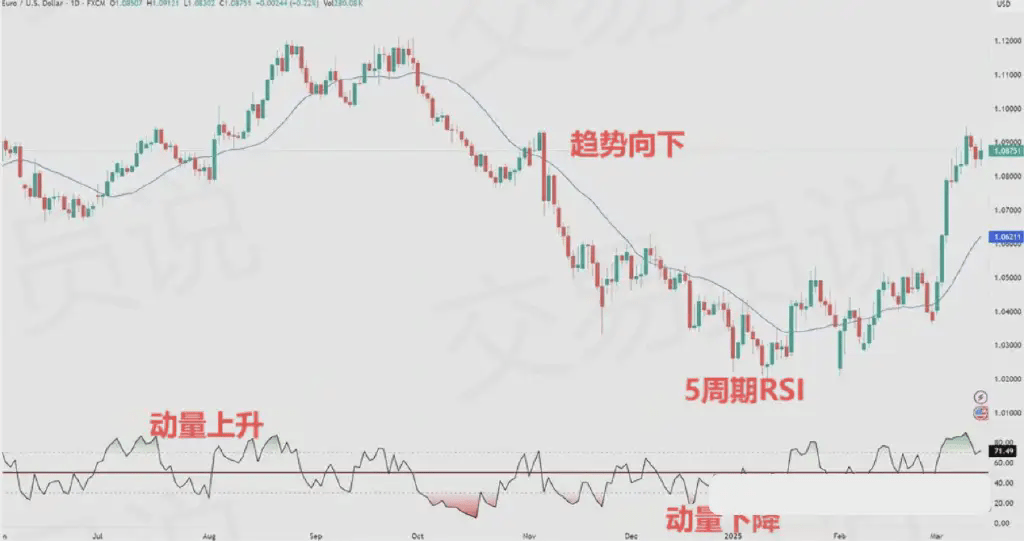
When looking for a reliable and uncomplicated forex trading strategy, the method of combining the 20 SMA and RSI is an excellent choice.
This method combines two powerful indicators that complement each other perfectly.
This strategy identifies trends through the 20-period Simple Moving Average while using the RSI to confirm momentum.
The 20 SMA is used to identify trend direction, while the RSI validates potential momentum, enabling more accurate trading decisions.
You will find that SMA crossover signals are particularly helpful in determining entry points, while RSI divergence analysis helps predict potential reversals.
The uniqueness of this method lies in its simplicity.
You do not need advanced technical skills; just follow clear trading rules.
To enhance performance, consider using support/resistance reversals as additional confirmation points to plan your entries.
Understand the core components of the 20 SMA strategy.
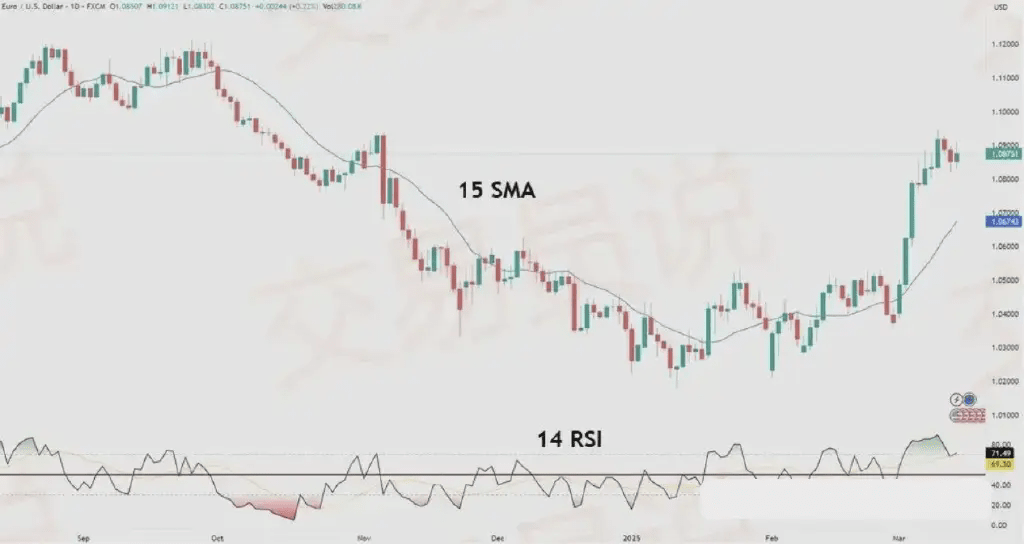
The core components of the 20 SMA and RSI strategy are built upon the principles we just discussed.
When applying this method, you will find that various SMA variants can improve your trading decisions. Some traders prefer to use 15 SMA for faster signals, while others may choose longer periods for smoother trends. The 15-minute chart provides an ideal balance for day traders, allowing quick market insights while maintaining enough data for reliable analysis.
Adjustments to the RSI are equally important - changing the recommended 5-period setting to 7 or 14 periods can significantly affect its sensitivity.
Remember, these components work together as a system, not in isolation. The key is to find a combination that matches your trading style and time frame while maintaining the strategy's core advantage in trend identification.
Set up charts for maximum effect
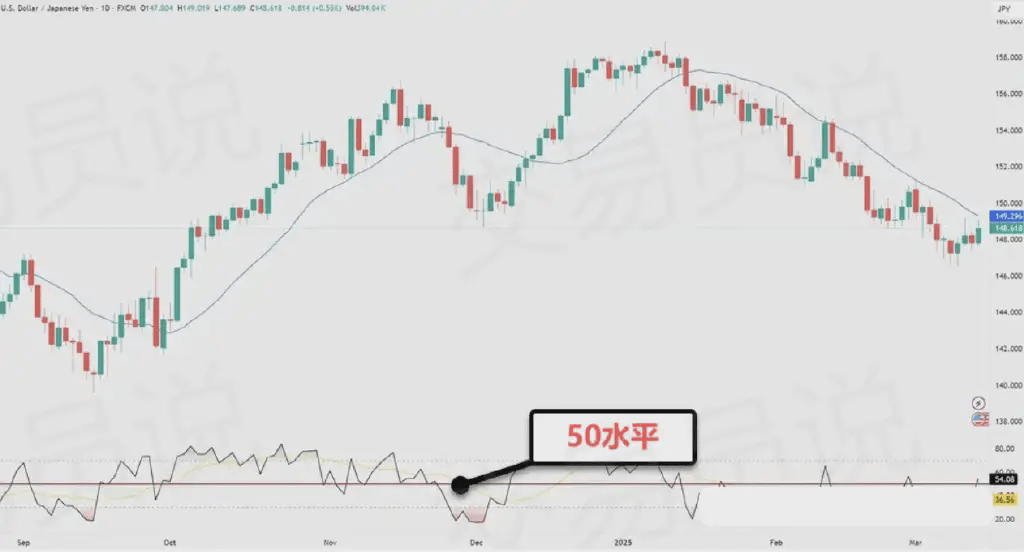
Correctly setting up the chart is essential for the success of the 20 SMA and RSI strategy.
First, choose your preferred time frame. This strategy is applicable to any time frame, but 4-hour or daily charts usually produce more reliable signals.
In the chart layout, add the 20-period simple moving average and set the RSI indicator to a 5-period.
These specific indicator adjustments are non-negotiable for the proper functioning of this strategy. Ensure that the RSI has a visible 50 level, as this is an important threshold for your trading confirmation.
The 20-period SMA will help identify medium-term trends while filtering out unnecessary market noise.
The psychology behind price behavior and moving averages.
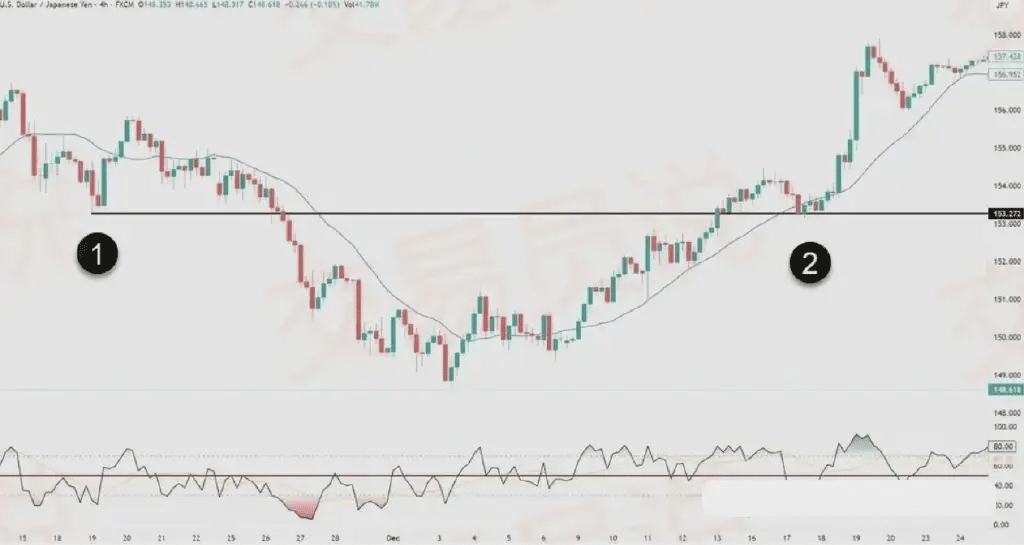
Understanding why the market reacts to moving averages reveals deeper psychological forces driving forex trading.
Moving averages are not just about tracking prices - they reveal the collective psychology shaping market behavior.
When the price approaches the 20 SMA, traders collectively decide based on their expectations of support or resistance.
This market psychology is reflected in price behavior - the visible footprints of all buying and selling decisions.
You will notice that prices often rebound from the 20 SMA like magic.
However, this is not magic; it is the collective effect of thousands of traders seeing the same signals and taking similar actions. Look left, and you may see the support/resistance structure that the price is reacting to.
Experienced traders often combine moving average crossover strategies to complement this analysis and confirm potential entry and exit points in trending markets.
Optimize RSI settings for the best signals

While many traders use the default RSI settings, customizing the RSI parameter to a 5-period (instead of the standard 14-period) can significantly enhance the signal responsiveness in this strategy.
This shorter cycle makes the RSI more sensitive to recent price changes, helping you catch trends earlier.
For ideal RSI settings, always keep 50 as the central line threshold.
When the price makes a new high but the RSI does not, pay attention to RSI divergence analysis - this often indicates a reversal.
When fine-tuning settings, remember that more sensitive indicators require more attention to filter out false signals.
Combining the 5-period RSI with the 5 SMA strategy can provide higher precision entry points for short-term trades.
Entry rules under uptrend conditions
When conditions for an uptrend appear, knowing when to enter can enhance your profit potential. Each strategy requires an appropriate entry strategy.
First, you need to confirm two key entry indicators: the price must be above the 20 SMA, and the RSI should be below 50, touching the bottom and starting to reverse upward.
Wait for the price to pull back to the 20 SMA, where the 20 SMA acts as dynamic support. Key point - look left and find some price structure support (like trading ranges, swing lows).
Once you see a confirmed candlestick pattern forming, set your buy stop-loss order above its high.
This systematic approach ensures you enter during trend momentum while leveraging market conditions to your advantage.
Entry rules under downtrend conditions.
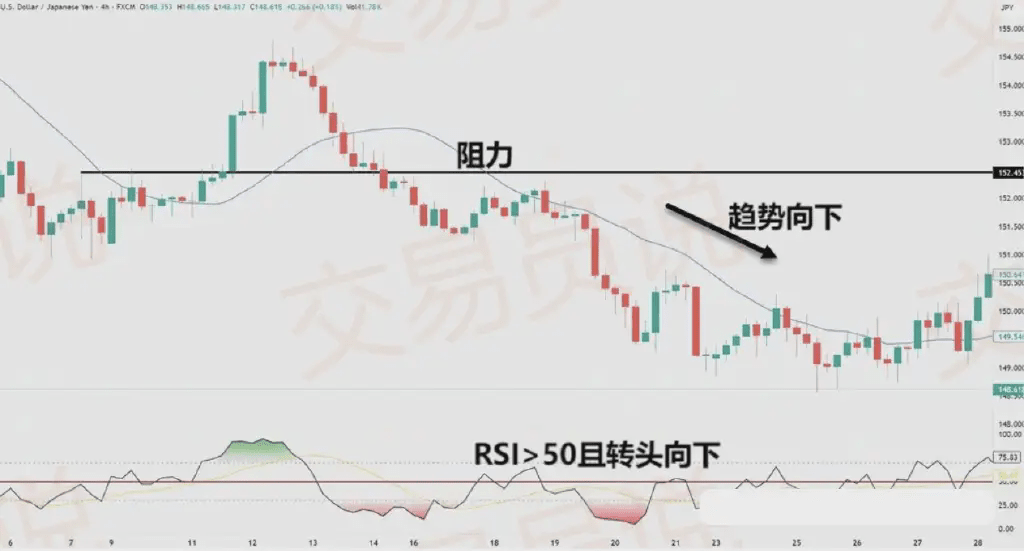
To profit under declining conditions, you need to follow specific entry rules to exploit downward momentum.
First, confirm that the price is below the 20 SMA, indicating a downtrend. Observe the price bouncing back from below and testing the 20 SMA.
Pay attention to bearish divergence signals on the RSI, which should peak above 50 and start to reverse downward. This market trend analysis helps identify suitable entry points.
Set your sell stop-loss order below the confirmed candlestick's low, and set stop-loss above its high.
To further validate, look for reversal candlestick patterns at resistance levels to enhance your bearish entry signals.
Stop-loss setting techniques that minimize risk
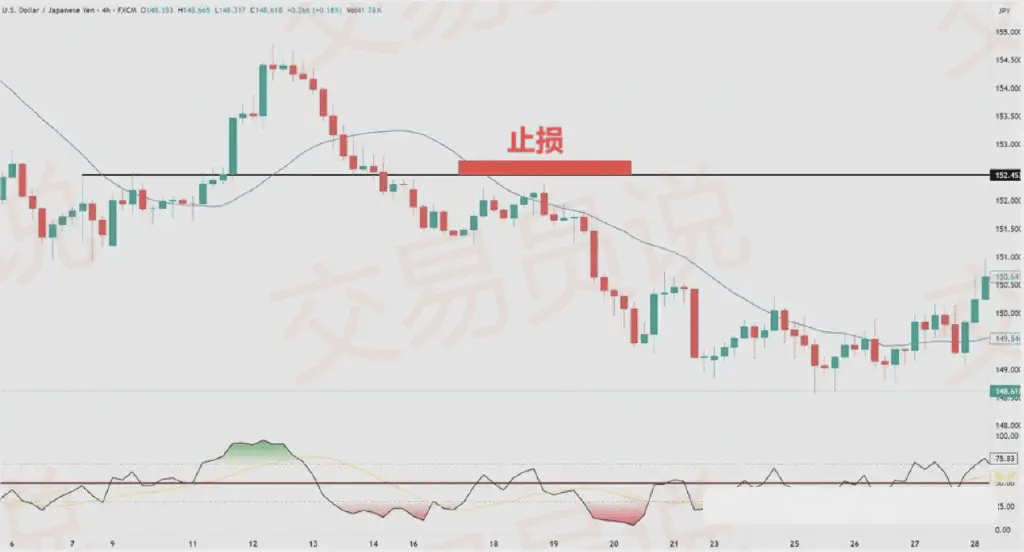
In forex trading, the correct stop-loss setting is the foundation of effective risk management.
When using the 20 SMA and RSI strategy, always set the stop-loss for selling positions above the high of the entry candlestick, or set the stop-loss for buying positions below the low of the entry candlestick. This protects you from sudden market reversals.
Combine stop-loss with position size management to ensure that the risk you take in any single trade does not exceed 1%-2% of your account.
This dual approach minimizes your risk exposure while allowing profitable trades enough space to develop into profitable positions.
Consider using the Average True Range (ATR) indicator to dynamically adjust stop-loss distances based on current market volatility.
Take-profit strategy to maximize profits
When trading the 20 SMA and RSI strategy, you need to implement effective take-profit techniques that align with market conditions. Setting the take-profit at three times the risk amount can create a favorable risk-reward ratio, maximizing profits while maintaining discipline. I would add that I can fully accept a risk-reward ratio of 1:1.25 because these smaller profits tend to be more stable.
Additionally, you can exit when opposing signals appear. In strong trends, consider using trailing stop-loss to lock in profits as the market moves in your favor. Understanding the market context is crucial for determining the most suitable exit strategy, similar to island reversal patterns.
Trading Plan: 20 SMA and RSI Forex Trading Strategy
Entry rules for long trades (buying)
1. Trend confirmation: Ensure that the price is above the 20 SMA, indicating an uptrend.
2. RSI signal: Confirm that the RSI has touched the bottom below 50 and is starting to reverse upward.
3. Pullback to the 20 SMA: Wait for the price to pull back to the 20 SMA, where the 20 SMA acts as dynamic support.
4. Confirm candlestick patterns: Look for bullish candlestick patterns (such as engulfing patterns or pin bars) forming near the 20 SMA.
5. Entry execution: Set buy stop-loss orders above the confirmed candlestick's high.
Entry rules for short trades (selling)
1. Trend confirmation: Ensure that the price is below the 20 SMA, indicating a downtrend.
2. RSI Signal: Confirm that the RSI has peaked above 50 and is starting to reverse downward.
3. Pullback to the 20 SMA: Wait for the price to rebound to the 20 SMA, where the 20 SMA acts as dynamic resistance.
4. Confirm candlestick patterns: Look for bearish candlestick patterns (such as engulfing patterns or pin bars) forming near the 20 SMA.
5. Entry execution: Set sell stop-loss orders below the confirmed candlestick's low.
Stop-loss settings
● Long trades: Set stop-loss below the confirmed candlestick's low.
● Short trades: Set stop-loss above the confirmed candlestick's high.
Take-profit strategy
● Set at least a 1:3 risk-reward ratio (for example, if the risk is 20 points, the target profit is 60 points).
● Alternatively, use trailing stop-loss to lock in profits as the trade moves in your favor.
● If the RSI shows divergence with the price trend, exit the trade, which indicates a potential reversal.
Additional Notes
● This strategy performs best on 4-hour and daily charts.
● Avoid trading during major news events to reduce the risk of false signals.
● Use candlestick patterns (such as pin bars, engulfing patterns) as additional confirmation for entry signals.
By following these precise entry and execution rules, you can confidently implement the 20 SMA and RSI strategy in your trading plan.
Adjust strategies across different time frames
The flexibility of the 20 SMA and RSI strategy is not limited to take-profit methods but can also be applied across various time frames.
The adaptability of this strategy allows you to conduct quick intraday trading on 15-minute charts or maintain long positions on daily charts.
When adjusting time frames, remember that higher time frames generally produce more reliable signals but fewer trading opportunities.
Lower time frames provide more frequent setups but may generate more false signals.
Start from the 4-hour chart to balance reliability and frequency while building confidence in the strategy.
When trading this strategy, be cautious of false breakouts, as the market often tests above key levels to trigger stop-loss orders before reversing.
Currency pairs best suited for this system
Four major currency pairs perform particularly well in the 20 SMA and RSI strategy: EUR/USD, GBP/USD, USD/JPY, and USD/CHF.
These currency pairs provide ideal trading conditions due to their liquidity and predictable trend behavior.
Major currency pairs provide the perfect combination of liquidity and predictable trends for effective technical analysis.
You will find EUR/USD particularly suitable for beginners as it combines stable trends with manageable volatility.
GBP/USD performs well during the London trading session, while USD/JPY excels in the Asian trading session.
To achieve the best results, avoid trading exotic currency pairs that may produce unstable signals (i.e., exotic currency pairs. These pairs typically consist of one major currency paired with a currency from an emerging economy. Examples include USD/RUB, USD/ZAR, etc.).
Stick to major currency pairs, as price behavior is more reliably consistent with the 20 SMA, creating clearer buying and selling opportunities.
These major currency pairs also allow for more effective stop-loss setups when trading at support and resistance levels.
Filter trades during major news events
When trading with the 20 SMA and RSI strategy, you should be cautious to avoid entering before or during major news events. News impacts may lead to sudden and unpredictable price fluctuations, rendering technical analysis patterns ineffective.
Pause trading at least 30 minutes before major economic data releases (such as interest rate decisions, non-farm payroll reports, or GDP announcements).
Resume trading 30-60 minutes after the event, once volatility calms down. This precaution prevents stop-loss triggers from news-related volatility rather than genuine trend changes.
Your strategy performs best under normal market conditions when price movements follow more predictable patterns.
Identify and avoid false signals
Just as you filter trades during major news events, identifying false signals is another skill for successfully trading the 20 SMA and RSI strategy. A false breakout occurs when the price briefly breaks the 20 SMA but quickly reverses, trapping careless traders who mistakenly believe the trend has changed.
To avoid these issues, always wait for signal confirmation before entering. Look for candlestick closing prices (not just shadows) breaking the SMA.
Ensure the RSI trend aligns with price behavior - if divergence occurs, proceed with caution.
Do not rush to enter. A few seconds of patience can prevent costly mistakes.
Use candlestick patterns to improve results
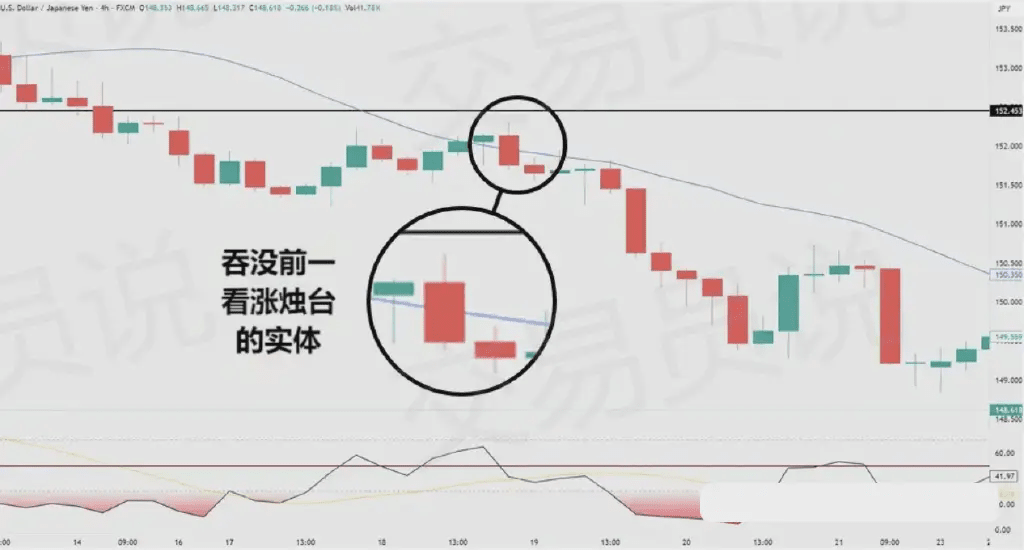
Combining candlestick patterns with the 20 SMA and RSI strategy can significantly improve your trading results.
Candlestick pattern psychology reveals market emotions that traditional indicators often overlook. When the price approaches the 20 SMA, look for specific patterns to confirm your entry signals.
1. Doji pattern: A doji near the 20 SMA indicates market indecision and may signal a reversal point, providing you with earlier entry opportunities than using RSI alone.
2. Engulfing pattern: shows a strong momentum shift, confirming the importance of the RSI signal.
3. Pin bar: A pin bar pointing in the direction of the trend and touching the 20 SMA forms a powerful resistance rebound signal that cannot be ignored.
Strategy evaluation
Successful traders recognize that measuring performance is not simply about tracking gains and losses. You need specific metrics to truly understand whether the 20 SMA and RSI strategy is effective.
First assess your win rate, risk-reward ratio, and maximum drawdown. These indicators provide clearer understanding than merely tracking account balance.
To measure performance, keep a trading journal recording your trades, noting the entry reasons and market conditions.
Strategy optimization is not a one-time task. Regularly review your results, identify patterns in winning and losing trades, and make small adjustments to improve results.
Frequently Asked Questions
1. Can the 20 SMA strategy be used with other oscillators (such as MACD, stochastic indicators, or CCI)?
You can, you can use other oscillators (like MACD, stochastic indicators, or CCI) instead of RSI in the 20 SMA strategy. These oscillator combinations provide alternative confirmation signals while maintaining the trend-direction function of the SMA.
2. How does this strategy perform during economic uncertainty or recession?
During periods of economic uncertainty, you will notice the effectiveness of the strategy decrease as market volatility disrupts trends. Your strategy performs poorly in price fluctuations caused by economic indicators and requires careful monitoring and adjustments to maintain profitability.
3. What is the recommended minimum account size for this strategy?
You should start with a minimum investment of $1000 to perform proper risk management. With an ideal leverage of 1:100, you will maintain enough margin while effectively implementing this strategy.
4. Is this strategy suitable for automated trading systems?
Of course, it is suitable, and you will find that this strategy is very suitable for automated trading systems (EA). Its clear entry, exit, and risk management rules can effectively translate into trading algorithms for consistent automated analysis.
5. How often should I reassess the effectiveness of my SMA-RSI parameters?
You should conduct a backtest once a month and reassess after significant market changes. Reevaluate your SMA-RSI parameters quarterly and adjust based on performance data to maintain the strategy's effectiveness.
Along the way, I've seen countless people get rich, blow up accounts, and return to zero...
I have also stepped into pitfalls, endured bear markets, and missed wave after wave of market opportunities.
Looking back, these 8 rules are the foundation that allows me to survive and keep moving forward:
1️⃣ Only use idle funds to participate
The money you enter the market with must be funds that you won't need in the short term. Living expenses, mortgage, retirement funds must not be touched. Losses should not impact your life; only then can you afford to wait for opportunities.
2️⃣ Strictly set stop-loss lines.
Always set a stop-loss for each trade; cut losses at 10%-15% directly. Small losses are not terrifying; deep entrapment is fatal. A stop-loss is not cowardice; it is a lifeline.
3️⃣ Refuse leverage and contracts
Leverage can allow you to double overnight but can also wipe you out overnight. During extreme market conditions, the risk is ten times greater than you think. To survive longer, first stay away from it.#炒币日记
4️⃣ Do not chase rises or falls.
The most bustling times in the market are often at highs, and the most panicked times are actually opportunities. Establish your judgment rather than dancing to price emotions.#Strategy增持比特币
5️⃣ Position management comes first.
Single currency position should not exceed 30%; do not operate without a full position. Keep ammunition to shoot when opportunities arise, rather than watching them run away.
6️⃣ Do not be superstitious about 'insider news'
What you hear as 'insider information' is often someone else setting a trap for you. Do your own research, focus on fundamentals, and don't be led by stories.
7️⃣ Learn to take profits.
The biggest enemy when making profits is greed. Set goals (double, +50%, etc.), and take profits in batches. The thrill of a roller coaster is not a way to make money.#特朗普允许401(k)投资加密货币
8️⃣ Control emotions
Do not rush to increase positions to make up for losses, and do not inflate positions when making profits. Calmness is the rarest ability of traders.
These 8 points are not trading skills, but survival paths.
Many people lose not because they cannot read the charts, but because their mindset, position, and discipline have all collapsed.$BTC
Remember, the crypto world is not short of opportunities; what is lacking is you surviving until the opportunity arrives.


